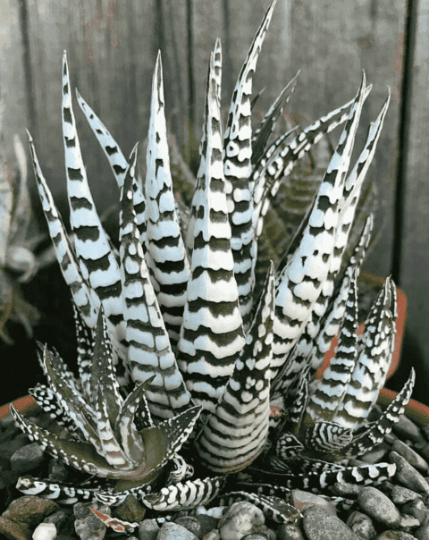
What is the Super Zebra Succulent?
The Super Zebra succulent, also known as the Haworthia fasciata, is a type of small, slow-growing succulent plant native to South Africa. It is known for its distinctive striped leaves that resemble a zebra’s stripes and its ability to thrive in bright, indirect light and well-drained soil. The plant is also known for its small size, making it a popular choice for indoor succulent gardens or as a decorative element in outdoor gardens.
Dimensions:
Can vary depending on various factors such as age, environment, and pot size. However, on average, a mature Haworthia fasciata plant can reach a height of around 5-8 cm (2-3 inches) and a width of 10-15 cm (4-6 inches). The rosette of the plant is usually about 5-7 cm (2-3 inches) in diameter. It’s important to note that these are just rough estimates and that the actual dimensions of a Super Zebra succulent may vary.
Zones:
This succulent is not hardy and is generally grown as a houseplant or in mild, temperate climates. It is not suitable for planting in outdoor gardens in areas with harsh, cold winters as it is not cold-tolerant. In terms of USDA hardiness zones, typically considered to be hardy in zones 9-11, where temperatures do not typically fall below 20°F (-6°C). If you live in a colder climate, it is best to grow indoors or in a greenhouse, where it can be protected from extreme temperatures and other environmental factors.
How to Tend:
Growing Outside
- Light: Prefers bright, indirect light but can tolerate some shade. Avoid direct sun exposure, which can scorch the leaves.
- Soil: Choose a well-draining potting mix for succulents, such as a cactus or succulent mix, or make your own by mixing sand, perlite, and peat moss.
- Watering: Water your Haworthia fasciata sparingly and allow the soil to dry out completely between waterings. Over-watering can cause root rot.
- Temperature: The Super Zebra succulent can tolerate temperatures between 50°F and 80°F (10°C and 26°C). Protect it from cold temperatures below 40°F (4°C) and hot temperatures above 90°F (32°C).
- Fertilizer: Fertilize your Haworthia fasciata once a month during the growing season (spring and summer) with a balanced, water-soluble fertilizer.
- Pests and Diseases: Haworthia fasciata is generally pest-free, but be on the lookout for mealybugs, spider mites, and scale insects. If you notice any issues, treat them promptly with an insecticidal soap.
By following these guidelines, you can help ensure that your Super Zebra succulent thrives in an outdoor environment.
Growing Inside
Here’s how to tend to a Super Zebra succulent indoors:
- Light: Place the plant near a window with bright, indirect light. Avoid direct sun exposure, which can scorch the leaves. If the plant is not getting enough light, its leaves may become elongated and lose their distinctive stripes.
- Soil: Use a well-draining potting mix for succulents, such as a cactus or succulent mix, or make your own by mixing sand, perlite, and peat moss.
- Watering: Water sparingly, allowing the soil to dry out completely between waterings. Over-watering can cause root rot, so it’s important to not over-water.
- Temperature: Keep the plant in a room with temperatures between 50°F and 80°F (10°C and 26°C). Avoid exposing it to temperatures below 40°F (4°C) or above 90°F (32°C).
- Humidity: Haworthia fasciata is native to a dry climate and does not require high humidity. Keep the air in the room where the plant is located well-ventilated to prevent mold and mildew growth.
- Fertilizer: Fertilize once a month during the growing season (spring and summer) with a balanced, water-soluble fertilizer.
- Pests and Diseases: Keep an eye out for mealybugs, spider mites, and scale insects. If you notice any issues, treat them promptly with an insecticidal soap.
By following these guidelines, you can help ensure that your Super Zebra succulent thrives indoors.
Where to Purchase?
You can buy this unique little thing in our Esty shop. Happy Shopping!!


